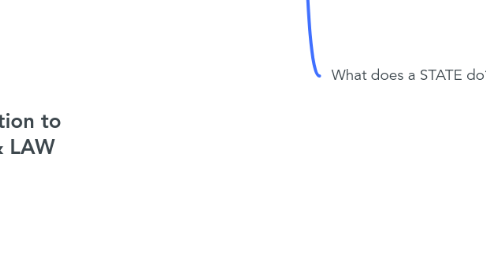
1. Introduction to STATE
1.1. How many common STATE forms are there in present?
1.1.1. National level: (Classification based upon who holds the state power and is the head of state)
1.1.1.1. Monarchy
1.1.1.1.1. Absolute monarchy
1.1.1.1.2. Limited monarchy: The monarch (a king or queen) is the head of state but shares the power with bodies selected by the citizen
1.1.1.2. Republic
1.1.1.2.1. Presidential republic
1.1.1.2.2. Parliamentary republic
1.1.1.2.3. Semi-presidential republic
1.1.2. Local level: (Classification based upon independence between local)
1.1.2.1. Unitary
1.1.2.1.1. A state - governed as one single power
1.1.2.1.2. Local state – does not have their own power independent to the central state
1.1.2.2. Federal
1.1.2.2.1. The central state –constituted by local states
1.1.2.2.2. Local states have their own state power independent to the central government
1.2. How is the STATE of Vietnam structured?
1.2.1. National assembly (legislative body)
1.2.1.1. Supreme people's court (Judicial body)
1.2.1.1.1. People's high courts
1.2.2. Provincial people's council
1.2.2.1. District people's council
1.2.2.1.1. Commune people's council
1.2.3. Government (Executive body)
1.2.3.1. Provincial people's committee
1.2.3.1.1. District people's committee
1.2.4. Supreme people's prosecution (Judicial body)
1.2.4.1. People's high prosecution
1.2.4.1.1. Provincial people's prosecution
1.3. What is a STATE?
1.3.1. An organisation
1.3.1.1. Have control over a territory
1.3.1.2. Sovereign
1.3.1.3. Hold special political power
1.3.1.4. Entitled to compulsorily impose tax
1.3.1.5. Entitled to enact law
1.4. What does a STATE do?
1.4.1. Performance of state powers
1.4.1.1. Legislative functions
1.4.1.2. Executive functions
1.4.1.3. judicial functions
1.4.2. Specific operation areas
1.4.2.1. Economic functions
1.4.2.2. Social functions
1.4.3. International relationship
1.4.3.1. Protect the country
1.4.3.1.1. Protect the sovereignty
2. Introduction to LAW
2.1. What is LAW and its nature?
2.1.1. A system of rules recognised and guaranteed by state to regulate all social relations within its territory (legal norms)
2.1.2. A tool of a state to govern social relations
2.1.3. Enforced by the state power
2.1.4. Regulate what persons can do, what persons must not do, or what persons must do
2.1.5. Persons will bear liability for breaches of law
2.1.6. Apply for all individuals and organisations within a territory
2.1.7. Made or recognised by a state
2.2. How is LAW structured?
2.2.1. Law
2.2.1.1. Law branches
2.2.1.1.1. Legal institutions
2.2.1.1.2. System of legal norms which have the same features and regulate a group of correlative social relations
2.2.1.2. A system of legal institutions which regulate social relations in a specific social field
2.2.2. VN law branch's structure
2.2.2.1. Branch of Constitutional law
2.2.2.1.1. Branch of Administrative law
2.3. Forms of Law/ Vietnamese Law
2.3.1. Statutes: A statute is a formal written enactment of a legislative authority that governs the legal entities of a city, state, or country by way of consent.
2.3.2. Judical precedent: Lower courts have to follow the decisions of higher courts. This is called judicial precedent, binding precedent or precedent.
2.3.3. Customs: A legal custom is the established pattern of behavior that can be objectively verified within a particular social setting.
2.3.4. Statutes are the most dominant form of Vietnamese law
2.4. Types of Legal systems:
2.4.1. Common law: where Judical precedent is dominant
2.4.2. Civil law : where Statute form of Law is dominant
2.5. How is LAW performed?
2.5.1. Do not do what the LAW forbids
2.5.2. Do what the LAW requires
2.5.3. Authority applies rules of LAW
2.5.4. Do or not do what the law allows
2.6. Breach of LAW
2.6.1. Types
2.6.1.1. A specific act of a subject
2.6.1.2. Intentional or unintentional act
2.6.1.3. Unlawful acts
2.6.1.4. Violator has liability capacity
2.6.2. Liabilities
2.6.2.1. Criminal liability
2.6.2.1.1. Apply for Crimes
2.6.2.2. Administrative liability
2.6.2.2.1. Apply for administrative violation
2.6.2.3. Civil liability
2.6.2.3.1. Apply for violations arising in civil branch
2.6.2.4. Disciplinary liability
